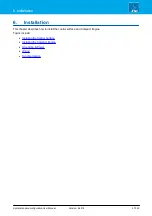
crystal standard configuration User Manual
Version: 6.4.0/4
28/149
6. Installation
4
MADI (optical)
In the crystal standard configuration, MADI ports 1 and 2 are not available for external use. They are used
internally to support the RAVENNA IO card (5).
MADI ports 3 (and 4) can be used to connect multi-channel digital audio to the system. The ports conform to
AES10 and carry 64 bi-directional channels (at 48kHz).
The two ports operate as a main and redundant connection: MADI 3 is the primary port and MADI 4 is the
redundant port. On the input side, the system will switch automatically to the redundant port if the primary port
fails. On the output side, the two ports carry duplicate signals. If redundancy is not required, then it is
recommended to connect your device to port 3 and leave port 4 unconnected.
All MADI connections must be point-to-point. The maximum connection length depends on the fibre type. The
connectors are MT-RJ.
Internally, the 64 MADI channels are configured for stereo operation within the available sources
and local
. This is important to remember when assigning audio onto the 64 mono channels in the connecting
device. For example, the stereo source "MADI 2" will use the audio arriving on channels 3&4; the stereo output
named "MADI 3" will send audio out on channels 5&6; and so on.
5
AoIP Streaming (CAT 5/6/7)
Expansion slot 1 is fitted with a RAVENNA IO Card (952/38) to stream audio to and from an IP network.
By default, 32 stereo streams are transmitted and received via the ETHERNET A port, while ETHERNET B
remains unused. The streams are fully compatible with the SMPTE ST2110-30/31, AES67 and RAVENNA
standards. Optionally, you can use both interfaces (A and B) to support redundant streaming via SMPTE
ST2022-7, Seamless Protection Switching. This requires some modification of the streaming configuration and
a supporting network infrastructure.
The connection(s)
must
be made via a network switch and
not
directly to another streaming port. Use a straight
(1:1) STP-CAT 5 network cable with RJ45 connectors. You can find more details about the data network
requirements and suitable components in the
The streaming network
must
be properly configured and managed. i.e. it must use a suitable network
architecture; all components must support multicast (as opposed to unicast); a proper Quality of Service
(QoS) must be configured; and so on.
Please
DO NOT
attempt to connect the streaming ports using an unqualifying IP network, as correct
operation cannot be guaranteed.
Internally, the first four Rx streams are reserved for stereo codecs, and the next 28 Rx streams for other stereo
sources. They are named RAV CODEC 1 to 4 and RAV 1 to 28 in the available sources
. A number of Tx
streams are also pre-defined; their default audio assignments are listed in the
See
















































